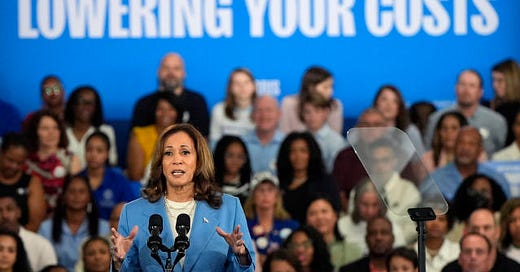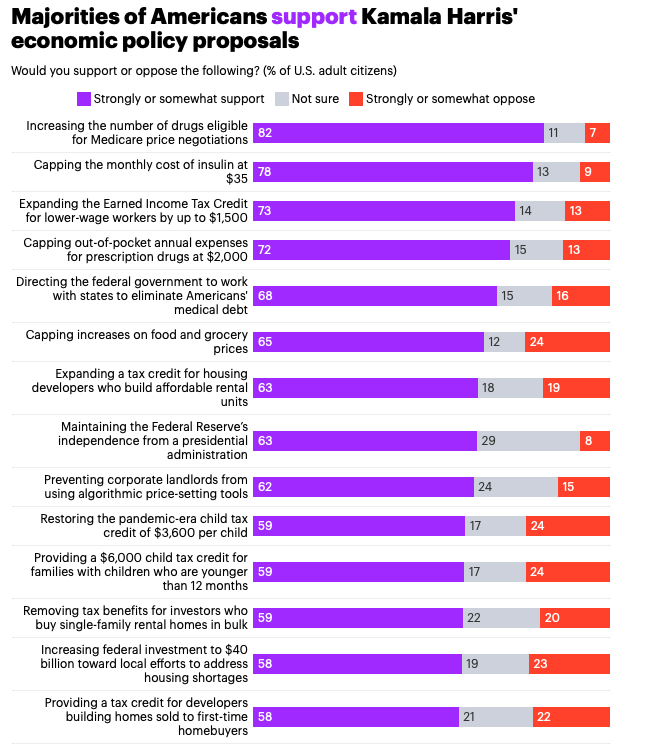The latest media narrative about Kamala is light on reality
Americans, for the first time ever, are clamoring for detailed white papers
Welcome to a Saturday edition of Progress Report.
I’ve been sick with some kind of flu for the past three days, so I have no real review or analysis of Vice President’s Kamala Harris’s DNC speech to offer. Polls in the field right now will give a first indication of whether the speech was effective in its one real goal: convincing people to vote for Democrats.
That said, I do have some thoughts on the way that the campaign is being covered, specifically when it comes to policy. That will be the focus of this newsletter, and I’ll follow it up with a second newsletter that runs through key stories from around the country.
Note: To make this work as accessible as possible, I’ve lowered the price for a paid subscription back down to Substack’s $5 minimum. If you can’t afford that right now, please email me and I’ll put you on the list for free. Every paid subscription makes it easier for me to comp one while becoming sustainable.
It’s always interesting to read about what goes on behind the scenes of these conventions, especially as it pertains to the perpetual power struggles between competing factions, but the only value that big picture punditry and “analysis” offers during these events is an insight into the storylines that are playing out in the media hive mind.
Too often, elections are artificially shaped by narratives invented by reporters and then propelled in directions that stray further and further from reality, each new story justified only by the previous one. While there are more than a few things about the Harris campaign worth scrutinizing — the lack of interviews, blocking a vetted Palestinian speaker at the DNC, and her relationship with Uber immediately come to mind — the media’s chosen fixation is as bizarre as it is wrong. And policy matters a lot to me; I wrote about Harris’s likely areas of focus before she announced them.
For at least the past ten days, reporters have been insisting that the Harris campaign is light on policy proposals. The first story I can find with that charge was published by the New York Times on August 14th. At that point, Harris had been the presumptive Democratic nominee for exactly three weeks, having suddenly assumed the mantle without warning after a seismic historical event.
Politicians should always be held to the highest standard, but demanding a full-on policy portfolio after just 21 days screamed of looking for something to criticize, not the least because the headline — “Harris Is Set to Lay Out an Economic Message Light on Detail” — was timed to the vice president’s release of her initial batch of economic proposals. The story claimed that members of Harris’s team promised proposals that would lack depth, but also noted that it wouldn’t be all that different from President Biden’s economic platform, which was plenty detailed.
What the campaign produced that day was a lengthy list of goals and proposals along with basic explanations of how some would be implemented. It included plans for tax policy, providing support for working families, addressing the housing crisis, lowering prescription drug prices, and pursuing a ban on price-gouging, among other items, and gave analysts plenty to chew on. Yet on August 19th, The Times produced a story with this lede:
When Hillary Clinton ran for president in 2016, she had more than 200 distinct policy proposals. Four years ago, Joseph R. Biden Jr. had a task force write a 110-page policy document for his White House bid.
Now, Vice President Kamala Harris does not have a policy page on her campaign website.
Again, it had been less than a month since Harris became the presumptive nominee, rendering the other campaigns irrelevant as points of comparison. The unique timeline of the Harris campaign was given a cursory nod before the bad-faith criticism continued in between acknowledgments of inconvenient realities.
This part really stood out to me:
On policy, she has essentially cherry-picked the parts of the Biden agenda that voters like most while discarding elements like his “Bidenomics” branding on the economy. She has emphasized what allies call the “care economy”: child care, health care and drug prices, which directly affect voters’ lives.
There is no area in which she is seeking a significant break from his agenda — perhaps not surprising given that she had a role in crafting much of it.
For somebody that has been “light” on policy, it sure seems as if Harris’s agenda was pretty well-defined by that point, even if it didn’t yet have a home on a brand new website. Anyone really seeking additional details could have found most of them in the Democratic Party’s official 2024 platform, which had her name on it and was published just a week before Biden dropped out of the race.
This week, Harris used her DNC speech to lay out her general vision for foreign policy, and while to me it was more conservative and concerning than any other plank of her platform, it wasn’t difficult to understand. Yet on Friday, even after four nights dedicated to outlining Democrats’ plans, major news outlets such as Bloomberg and Reuters were still calling Harris’s policy platform light on details and insisting that pressure was growing on her to provide more specifics.
Who were the people applying that pressure? I can promise you that there hasn’t been a groundswell of voters clamoring to understand how Harris would pay for her housing proposals, which happens to be the question that reporters ask most often about progressive policy.
Keeping the game tight
This is how the toxic narrative cycle works — inventing storylines, ascribing them to public opinion, and using the wealth of prior stories and supposed popular demand to justify further pursuit. In this case, the flames have been fanned further by the media’s unofficial assignment editor, Donald Trump, and the outspoken business leaders who want a more finance and monopoly-friendly presidency.
The Bloomberg piece noted that the DNC stage included billionaires, business leaders, and Bernie Sanders, but ideological tension in the future doesn’t mean that Harris’s monthlong emergency campaign has been unreasonably short on details or that voters are demanding more of them.
If anything, this is an effort by the media to manufacture tension and conflict in a campaign that is getting away from Trump. In sports video games, the artificial intelligence is always calibrating to the skill level of different players, lending a hand to the losing team and making life difficult for the team with the lead. It’ll sometimes manifest in embarrassingly transparent manipulation, like a clear homer landing in an outfielder’s mitt or a perfectly executed pass going through the hands of a receiver. That’s what seems to be happening with campaign coverage, both because the press want a tight game and because they want to reel back control of a Harris campaign that has soared beyond anyone’s wildest expectations after so many years of Biden gasping for good PR.
Not only is this not being done in the public interest, Americans actually seem pretty clear on Harris’s economic proposals — and they largely support them. YouGov surveyed voters after the vice president laid out her economic plans, and none of the 17 policies they polled scored less than 50% approval. Some were far higher — increasing Medicare’s power to negotiate prices with drug companies had 82% support, capping annual out-of-pocket payments for prescription drugs had 72% support, and banning price-gouging on groceries was supported by 65% of respondents.
Voters didn’t seem to indicate all that much uncertainty when they were asked to reflect on her proposals, either. Far more Americans believed that Harris would lower the price of health care (44%-34%), while more modest pluralities thought she’d be better on housing prices (40%-36%) and food costs (39%-38%).
I always welcome more policy details, and should she win in November, a big part of my job will be to push a President Kamala Harris to pursue the policies that most help working people. There just isn’t all that much ambiguity about what she says stands for right now.
What about Trump?
Out of curiosity, I did some Googling to see how often Donald Trump was accused of being light on policy by the media this election cycle. As I suspected, I couldn’t find one instance of it; few stories spoke about any policy whatsoever.
He’s hasn’t stopped running for president since 2020, yet his website’s policy section is far thinner than even the initial list of proposals that Harris released earlier this month. This is what he has to say about the economy, with actual proposals highlighted:
Donald Trump’s whole economic plan is “lower taxes, bigger paychecks, and more jobs for American workers,” yet the media hasn’t harangued him for more details or explanations about how his non-existent proposals will work.
Here’s what Trump proposes on health care costs, again with proposals highlighted:
The only actual policy proposed here, ending surprise medical billing, was already accomplished by the Biden administration with a rule announced in September 2021. OK, one more — check out the energy proposal:
The US is producing more oil than ever before and the Green New Deal never got a sniff in Congress. Other than that, great plan, Donald. But this isn’t even about him — nobody should expect more out of Donald Trump, but that doesn’t mean he should enjoy such a dramatically lower standard.
At one point, Trump’s plans were publicly understood to be outlined in Project 2025, the conservative plan to dismantle government and poison the American people. But since Trump pretended to disavow that Heritage Foundation-led plan, there has not been any obvious effort to ask him what he does plan to do as president, because nuance and accountability do not seem to apply to covering Donald Trump.
Wait, Before You Leave!
Progress Report has raised over $7 million dollars for progressive candidates and causes, breaks national stories about corrupt politicians, and delivers incisive analysis, and goes deep into the grassroots.
None of the money we’ve raised for candidates and causes goes to producing this newsletter or all of the related projects we put out. In fact, it costs me money to do this. So, I need your help.
For just $5 a month, you can buy a premium subscription that includes:
Premium member-only newsletters with original reporting
Financing new projects and paying new reporters
Access to upcoming chats and live notes
You can also make a one-time donation to Progress Report’s GoFundMe campaign — doing so will earn you a shout-out in the next weekend edition of the newsletter!
Hb











This is really insightful, and I think it’s a very interesting point
The for-profit news model is a problem. They don't care about truth or informing people or the state of the country they just care about money. Or at least the bosses of the journalists do. Got to have a horse race so if an evil scumbag is down then you better be hard on the other team because "fairness" of course. It could lead to cultural suicide.